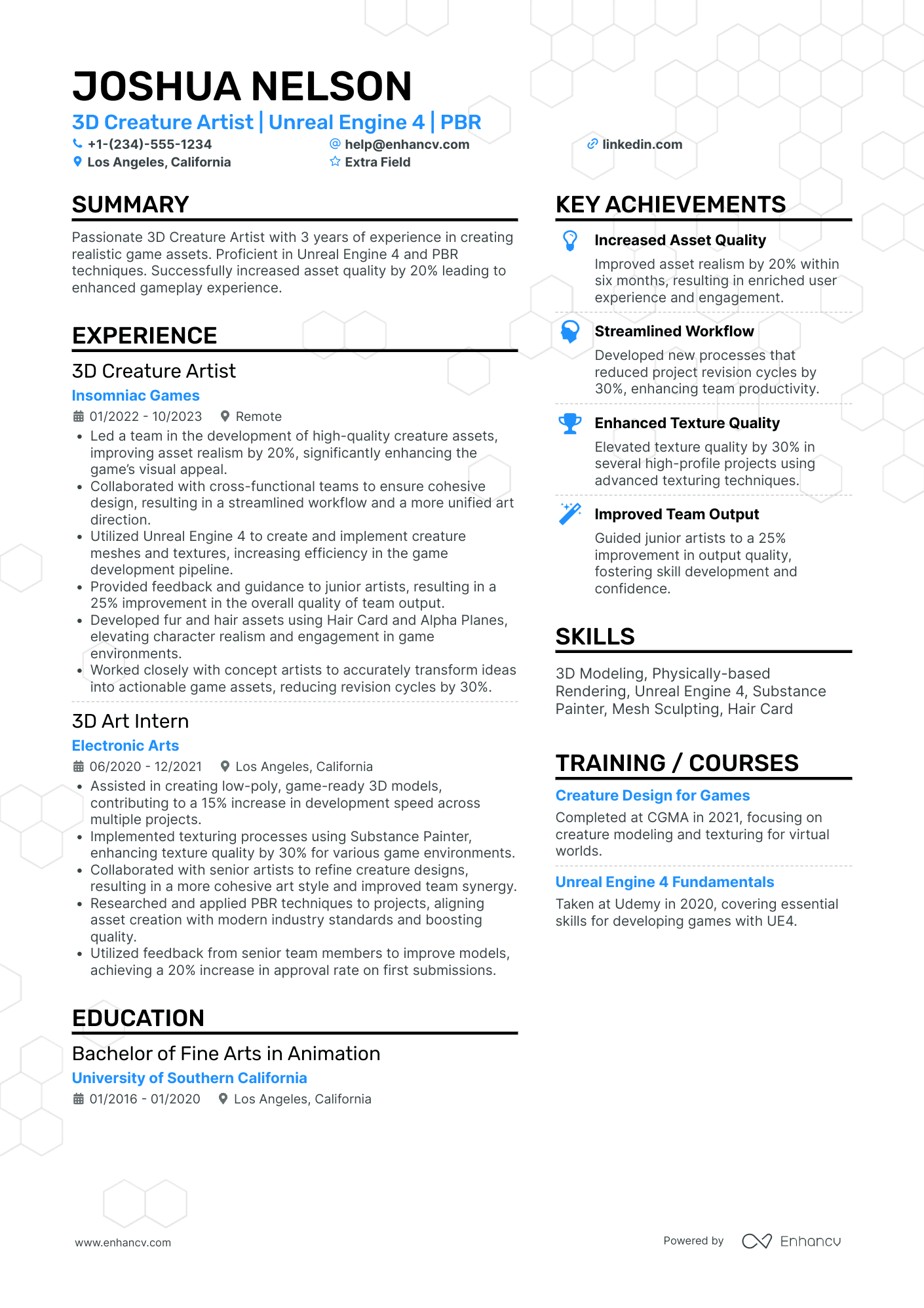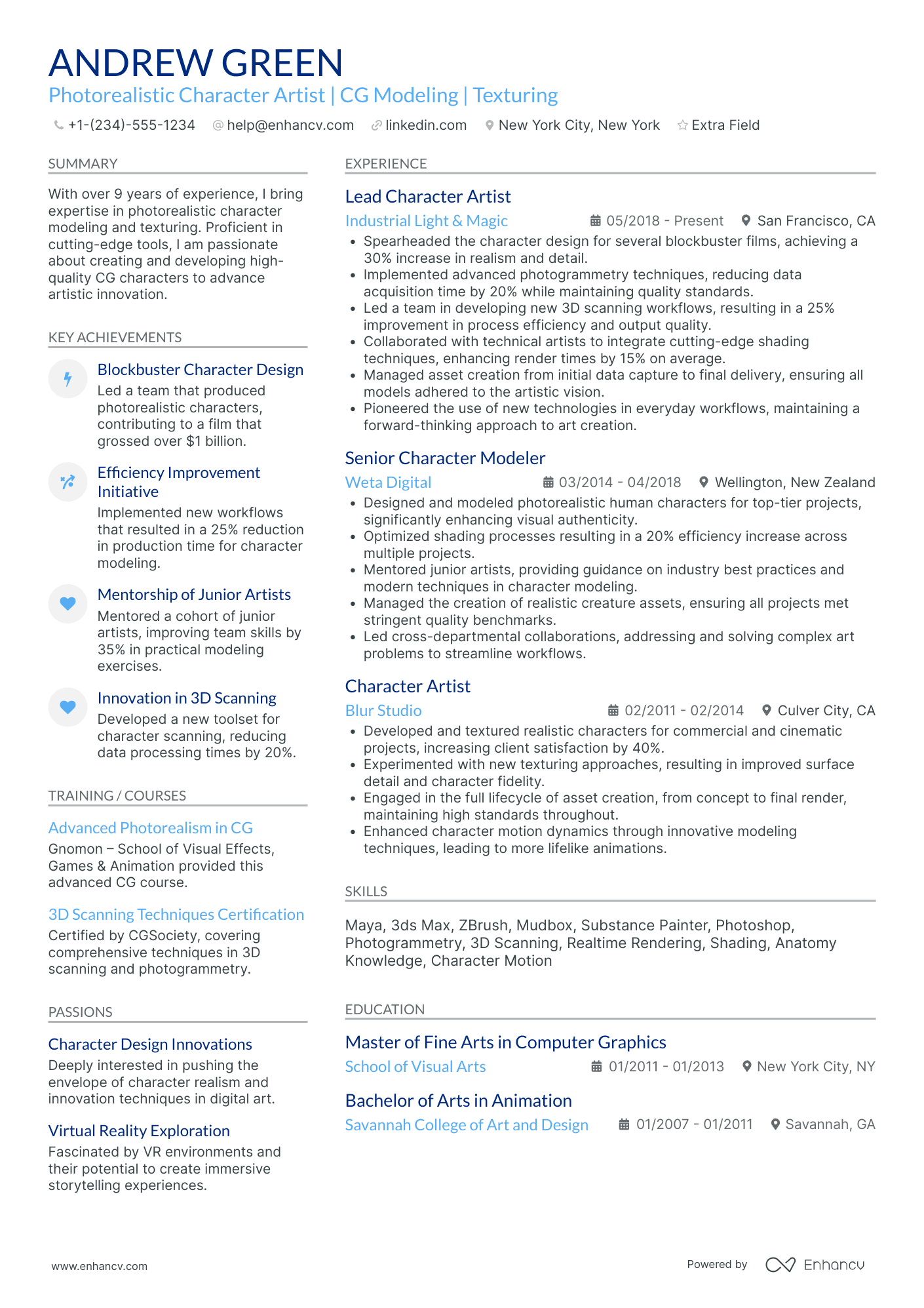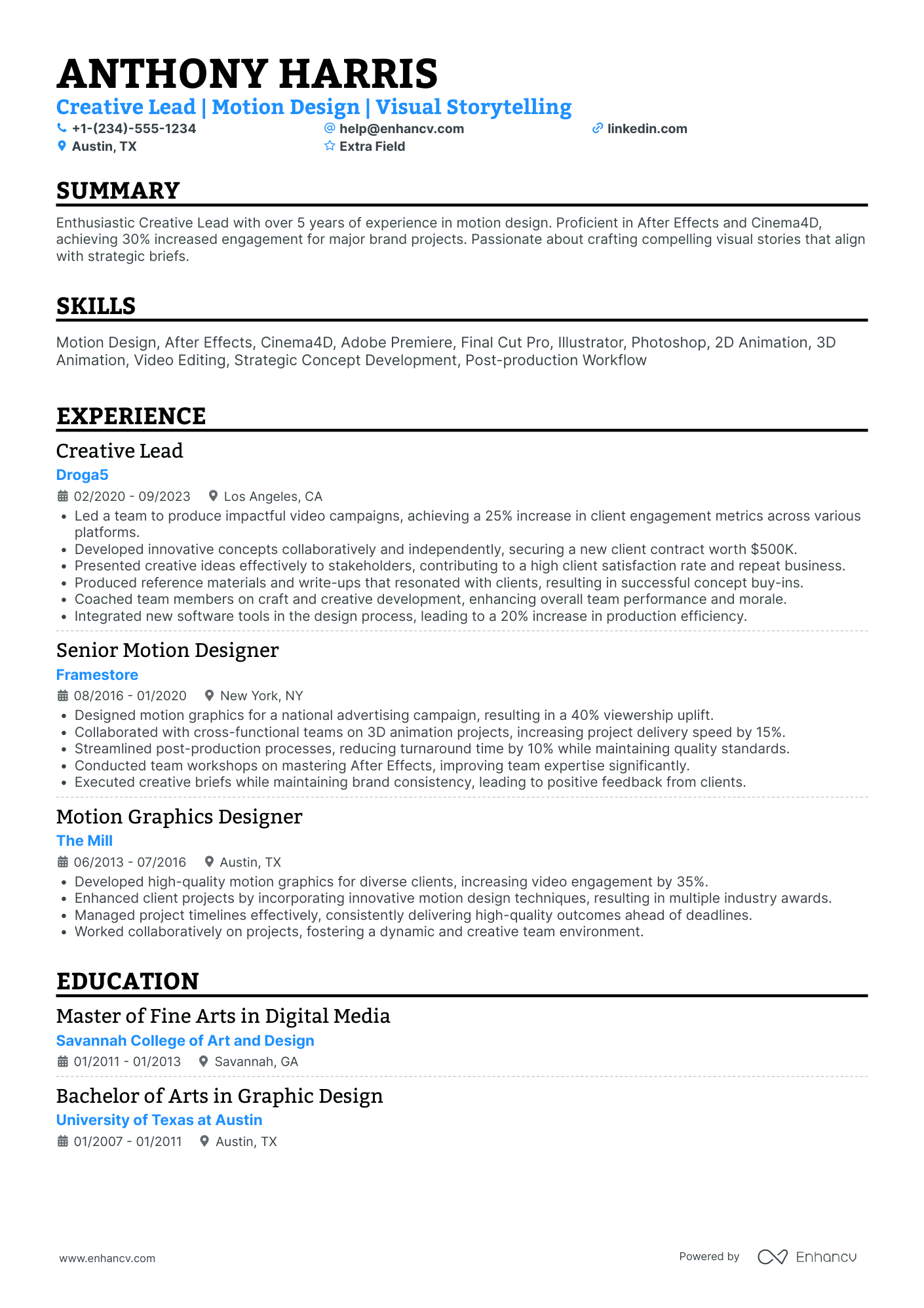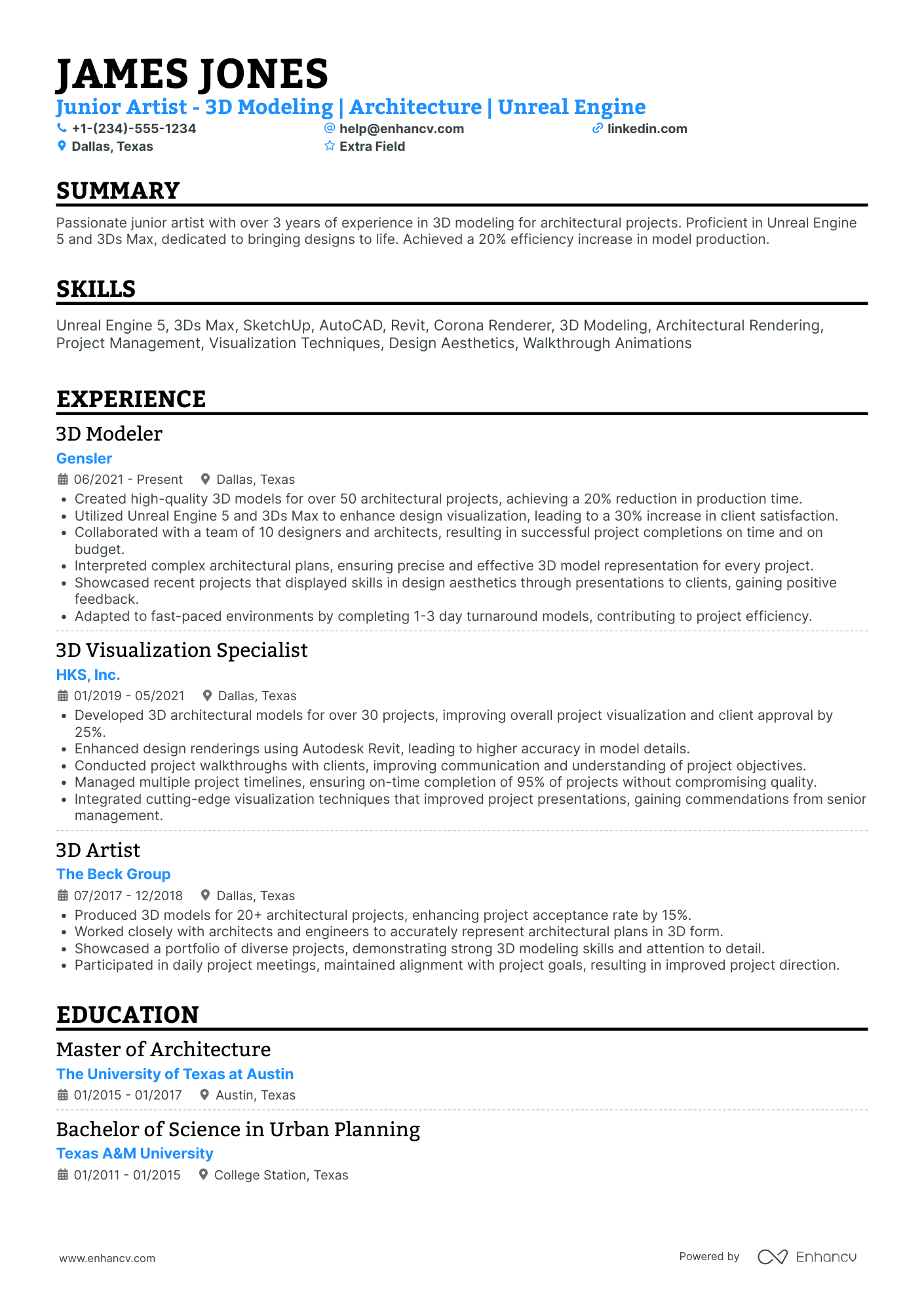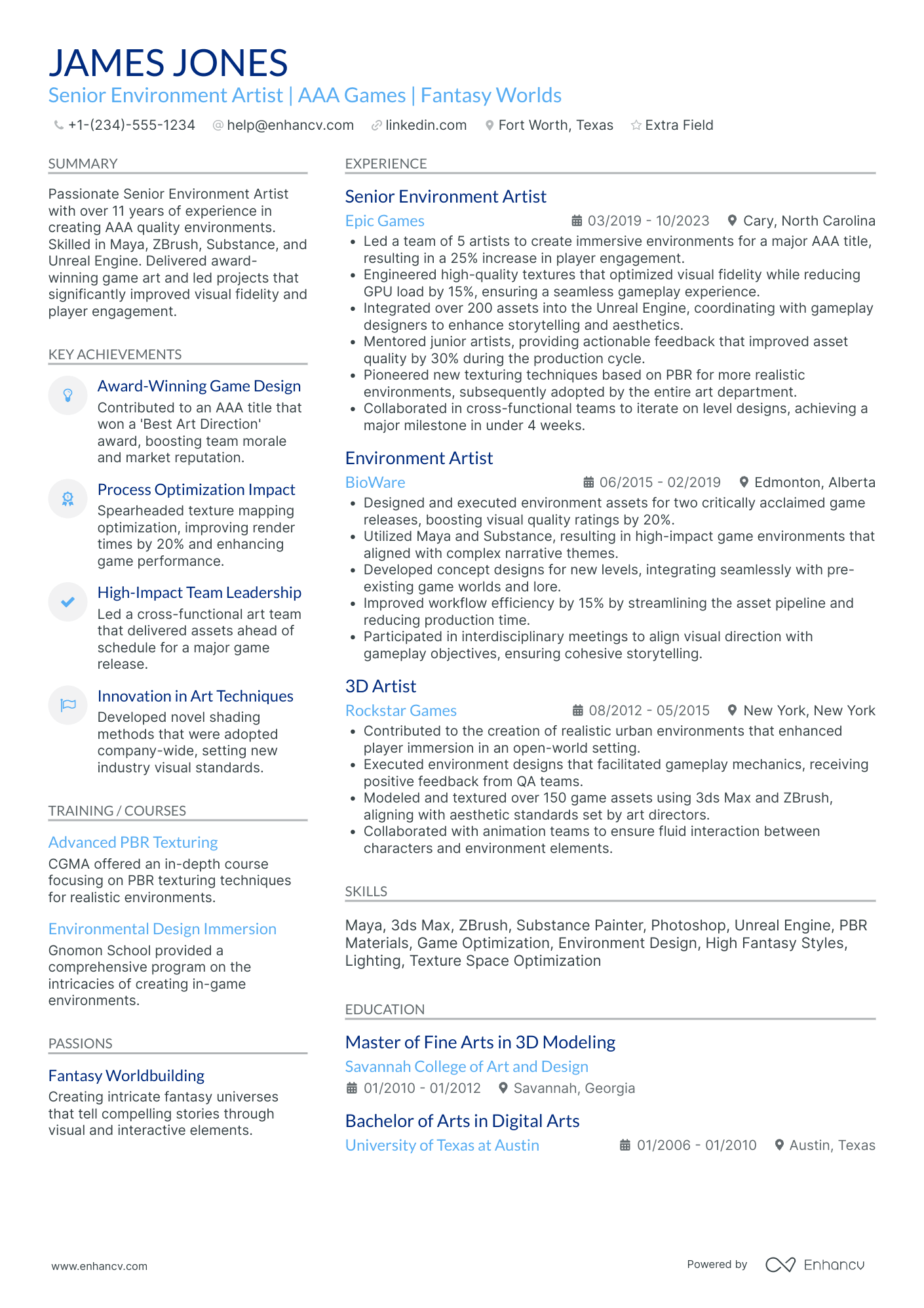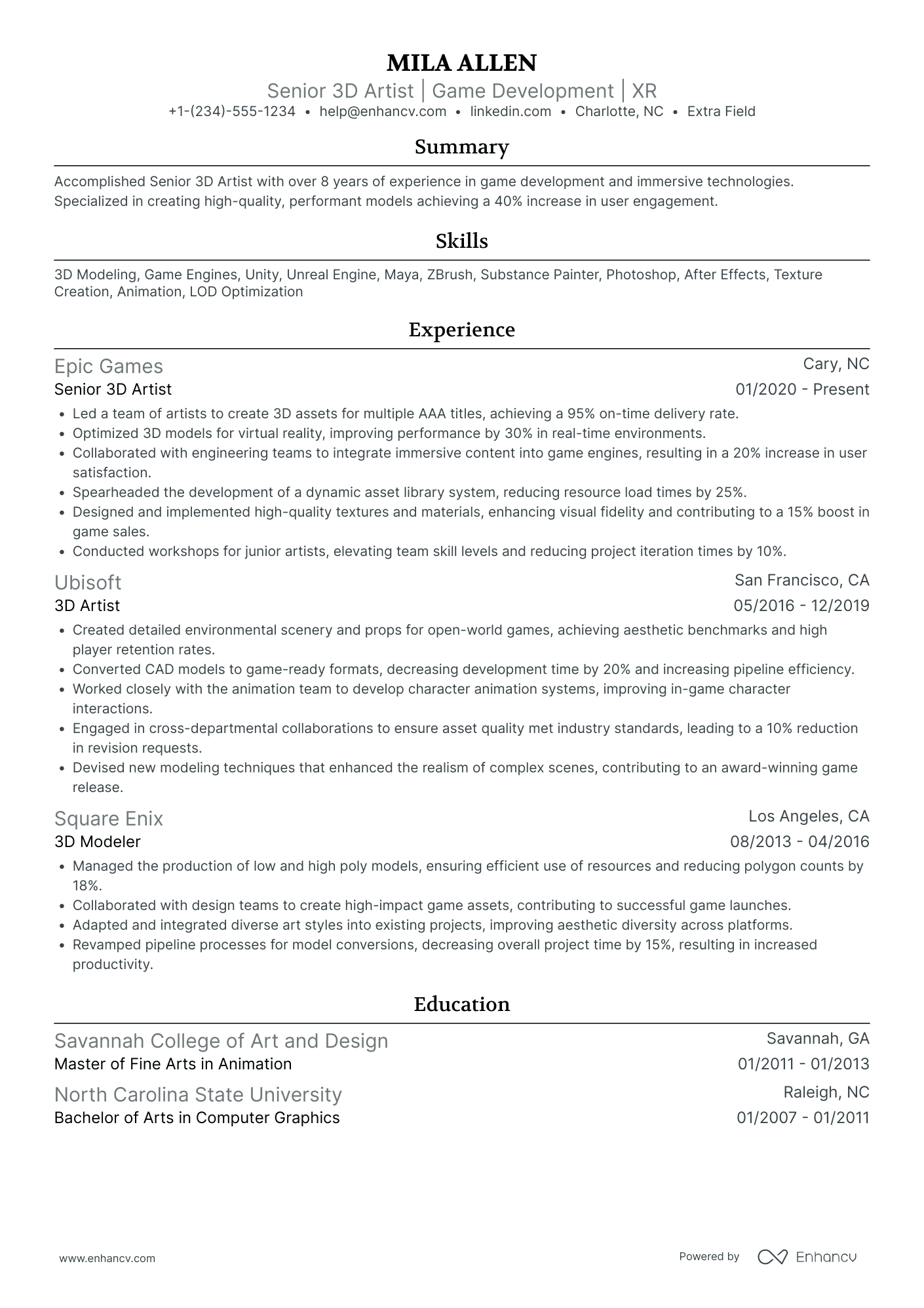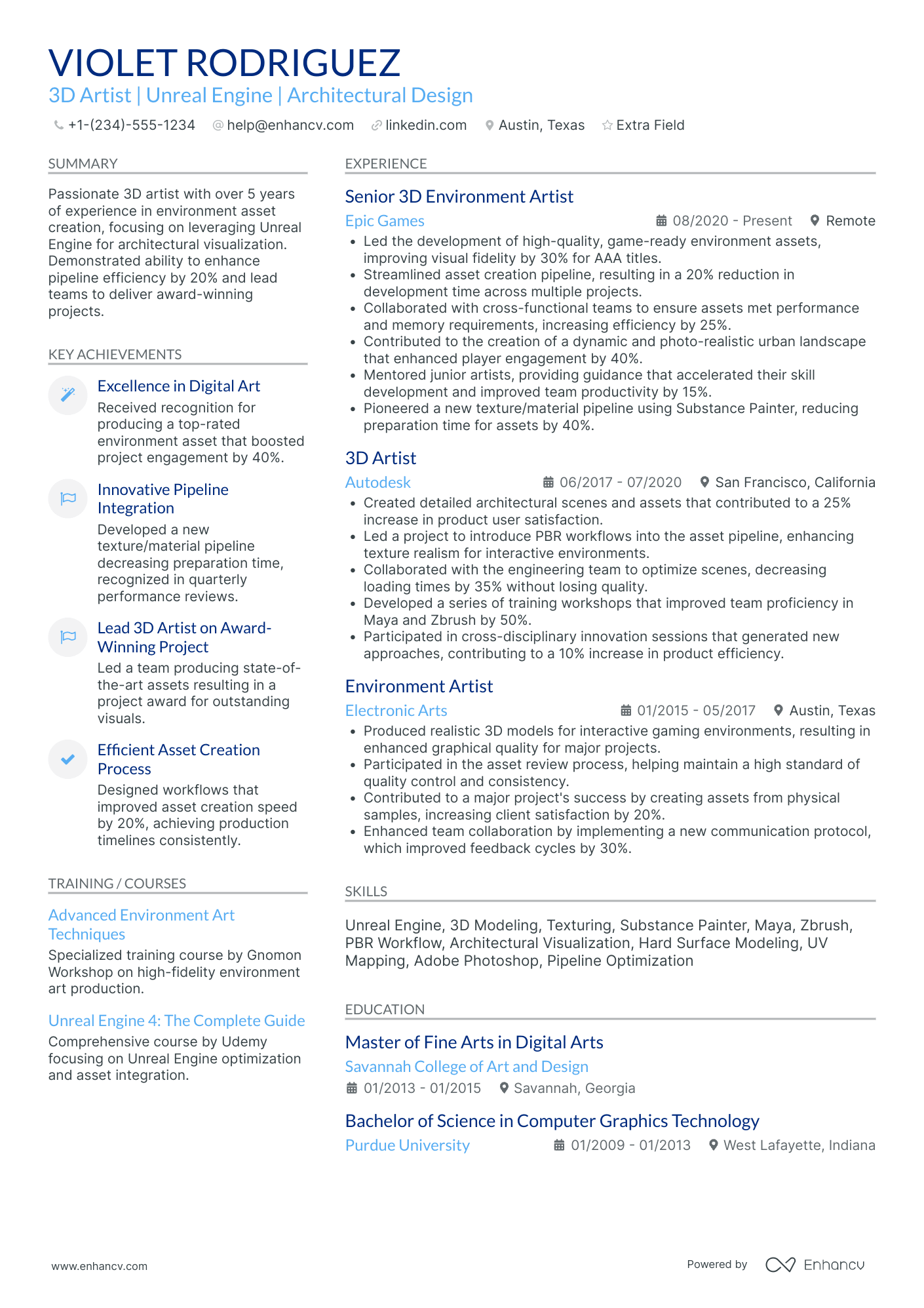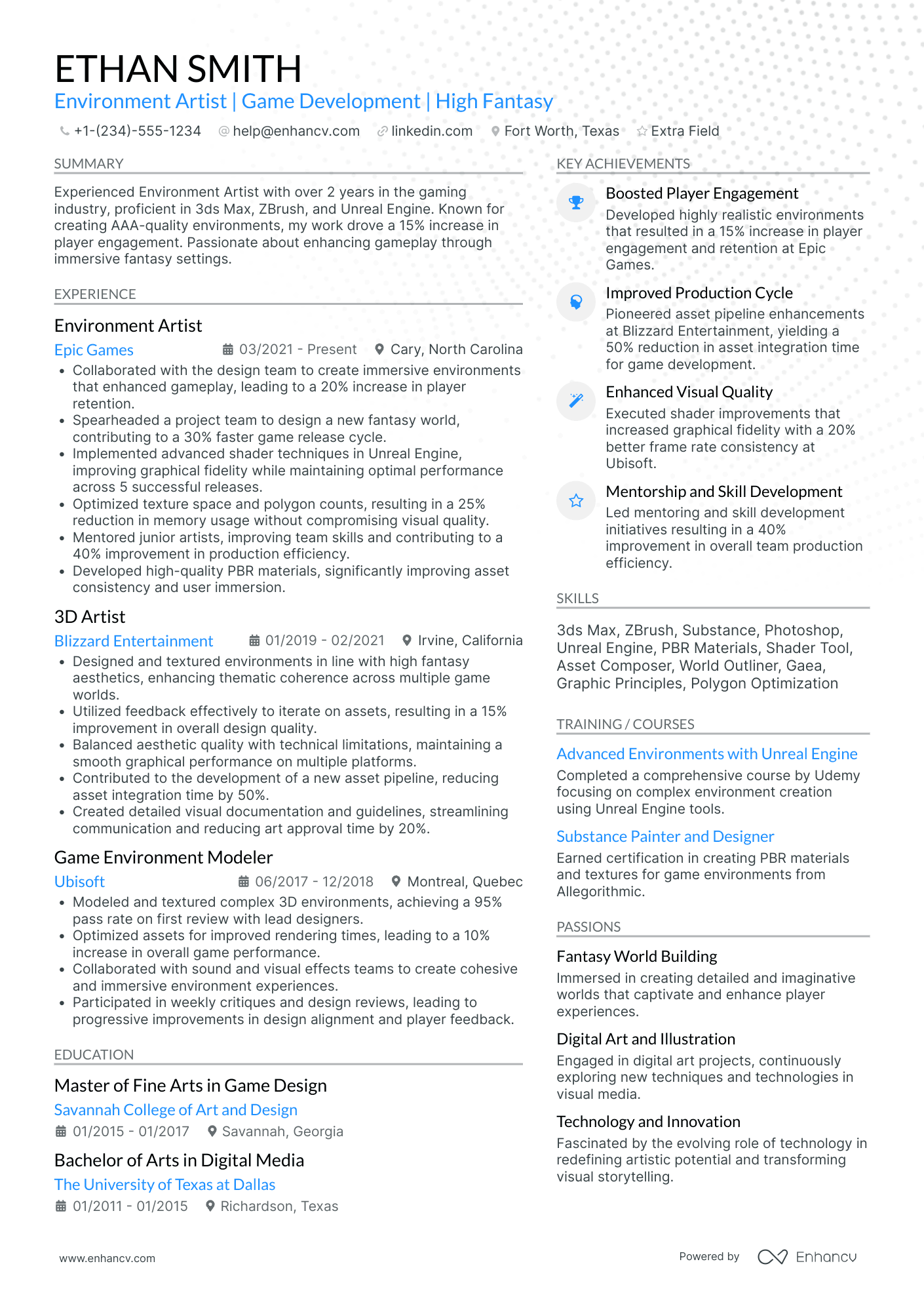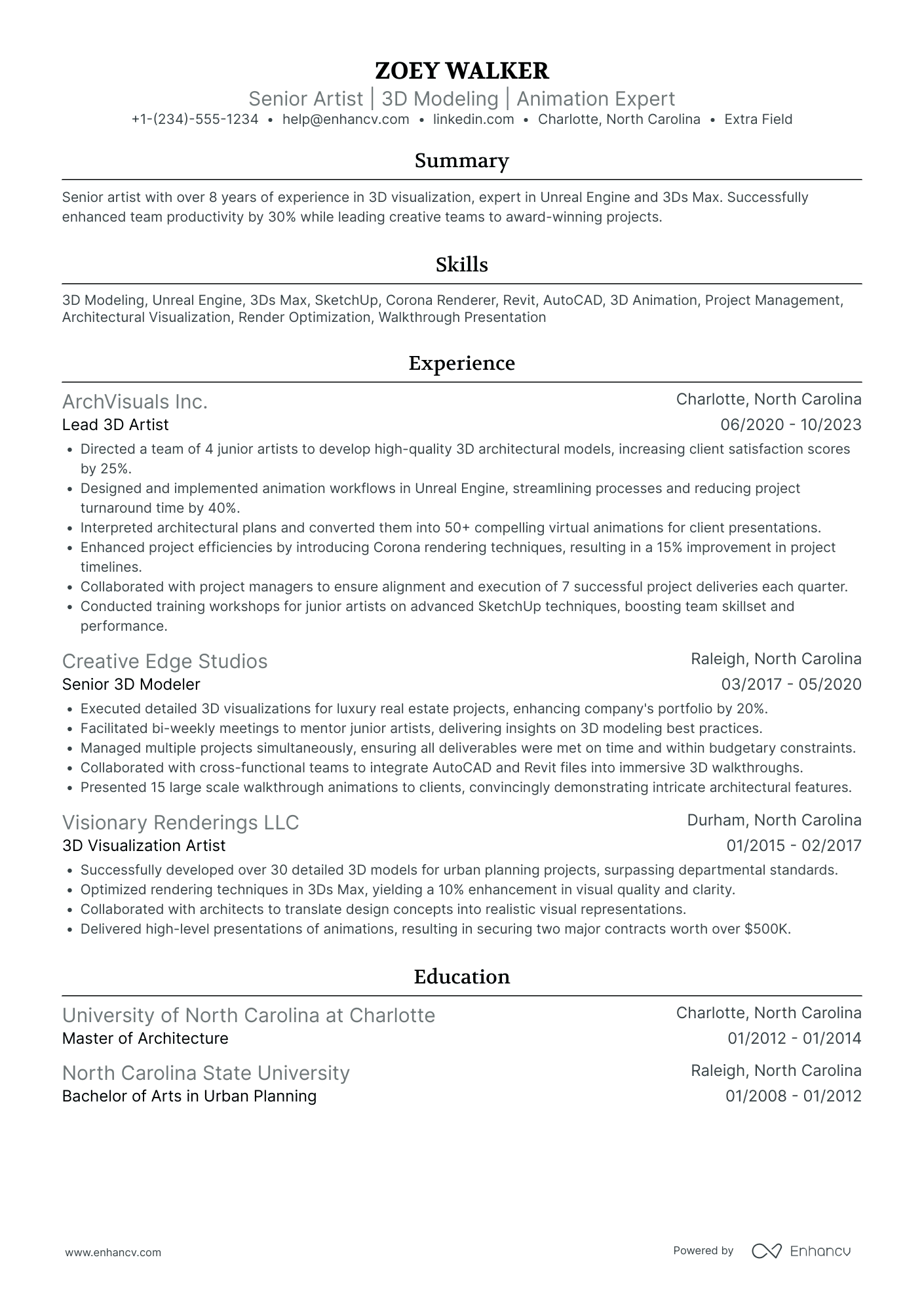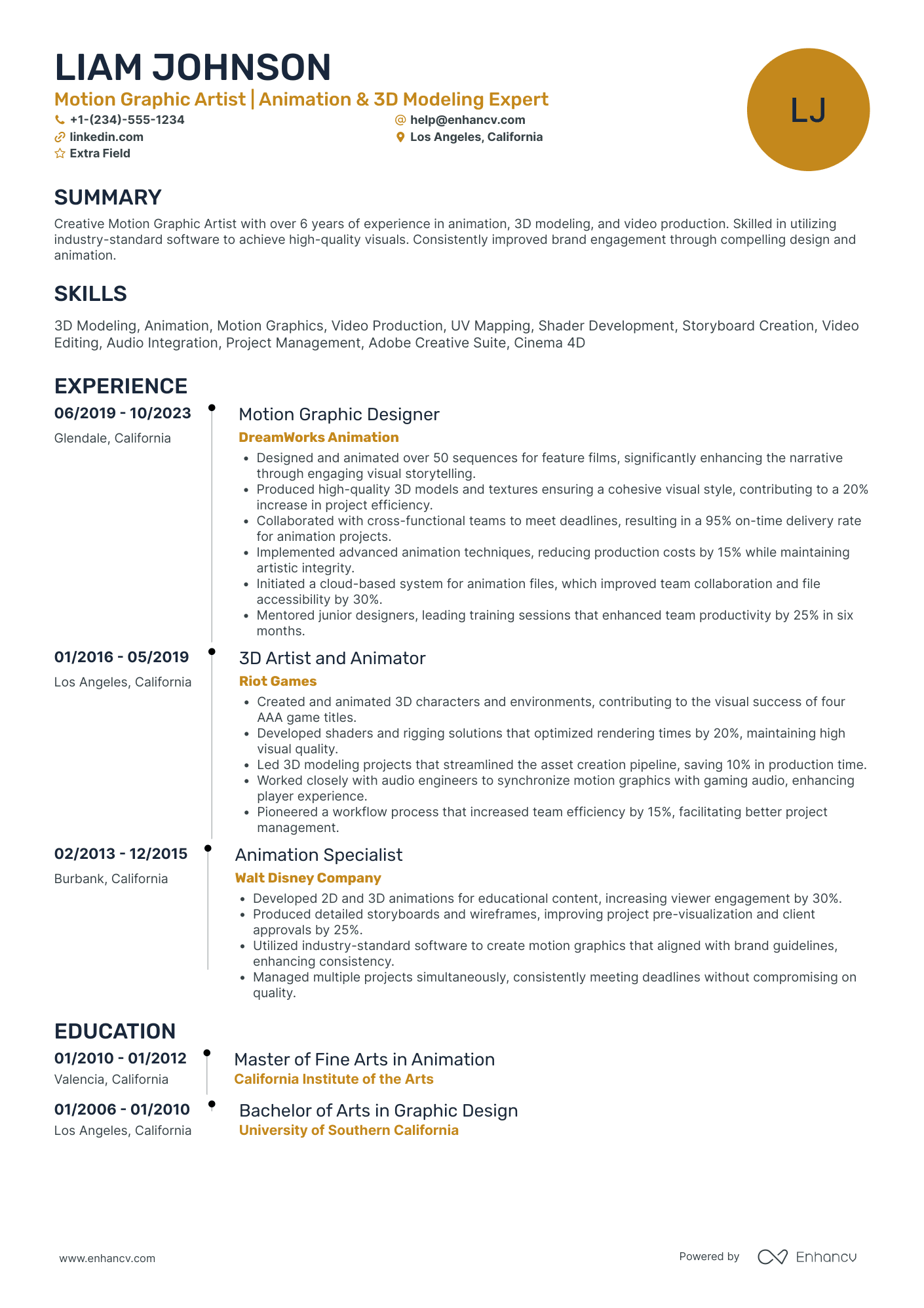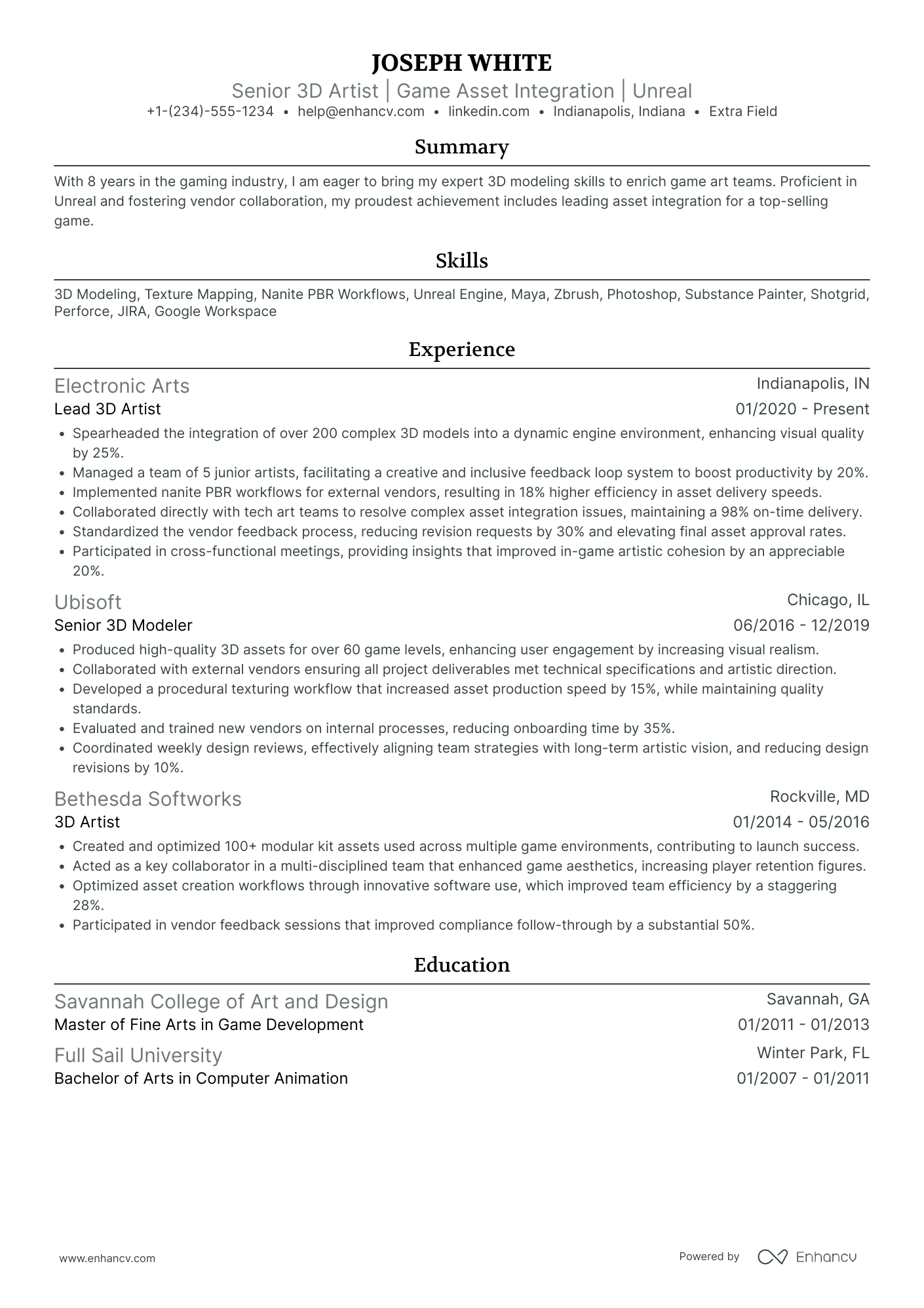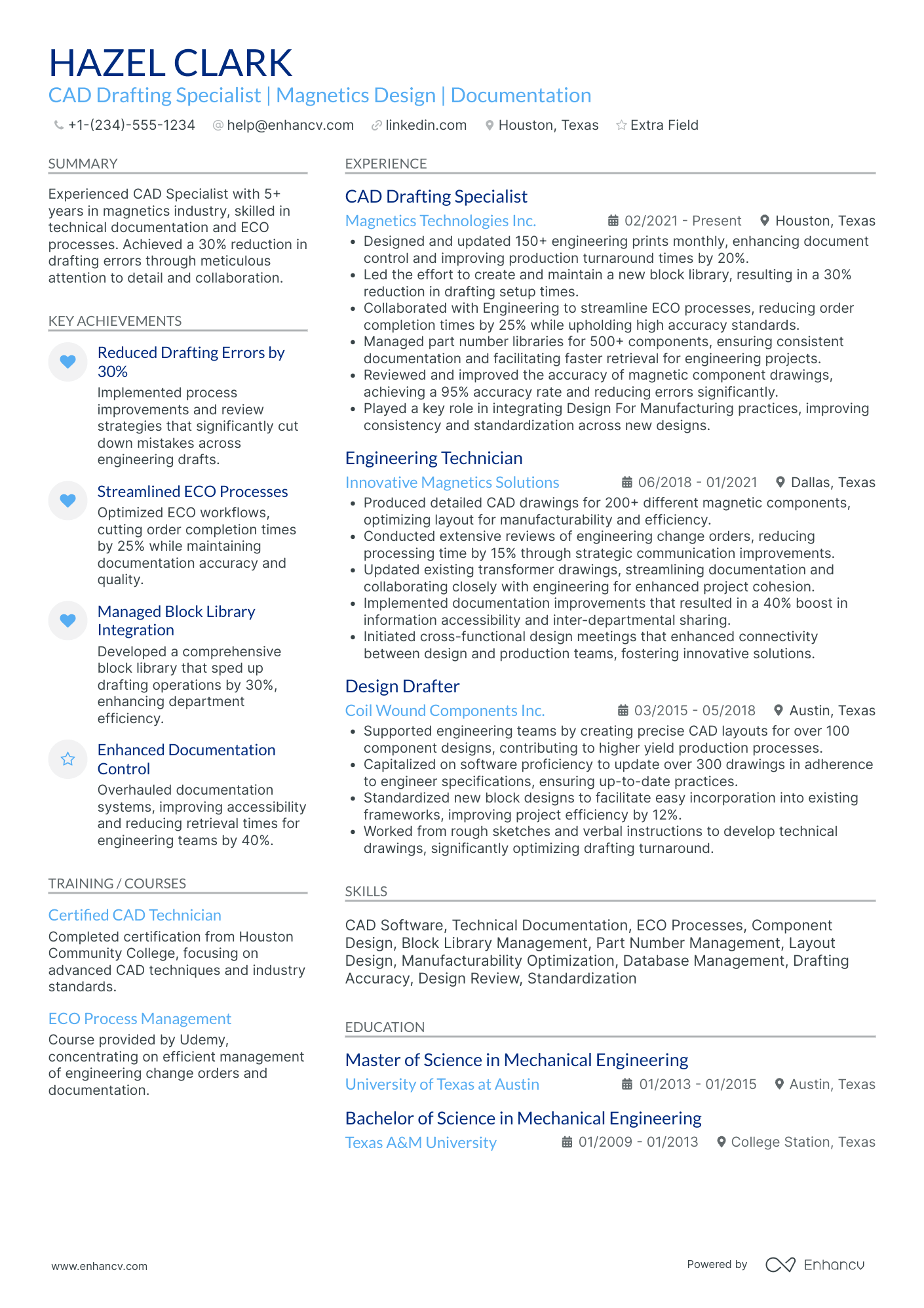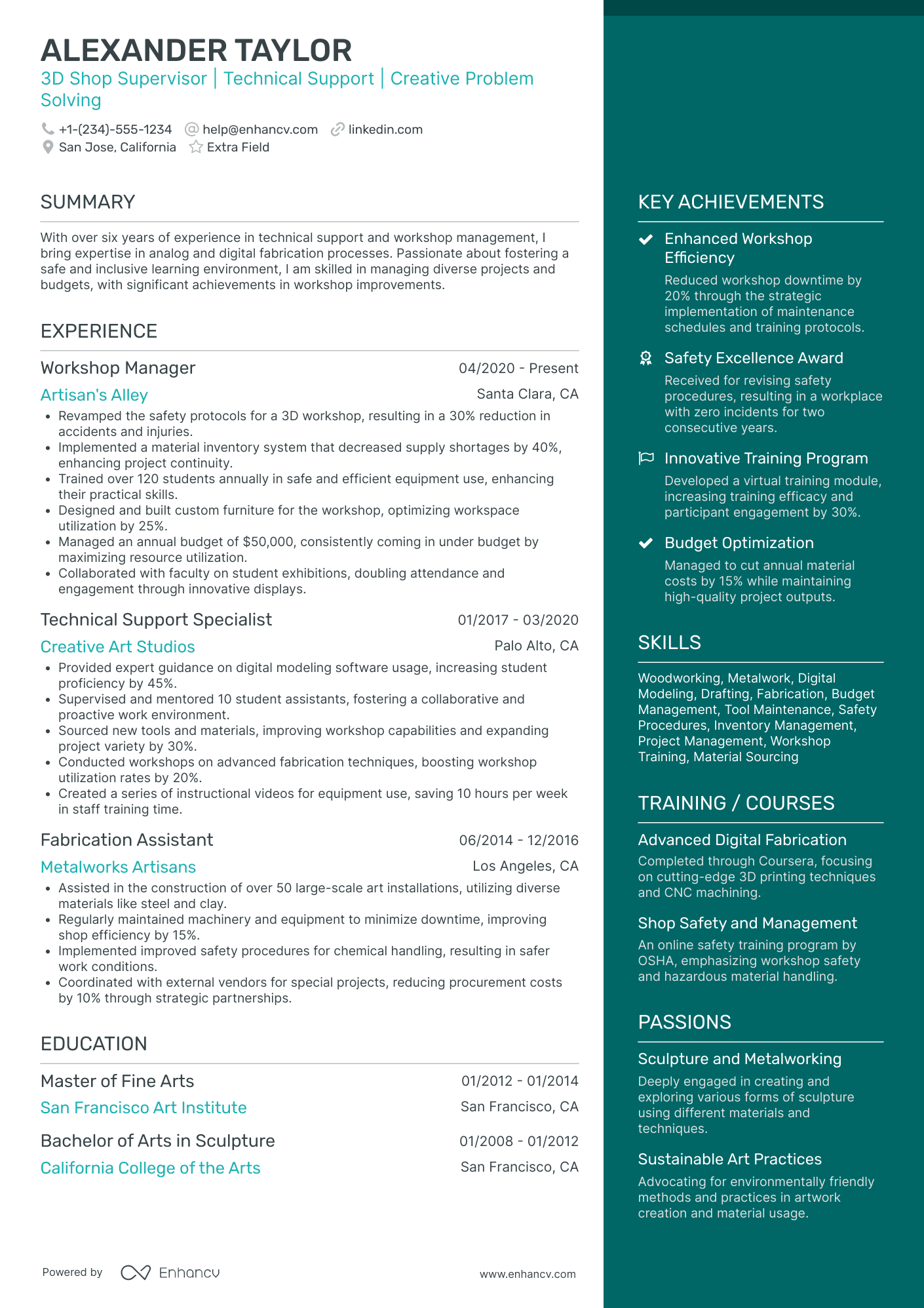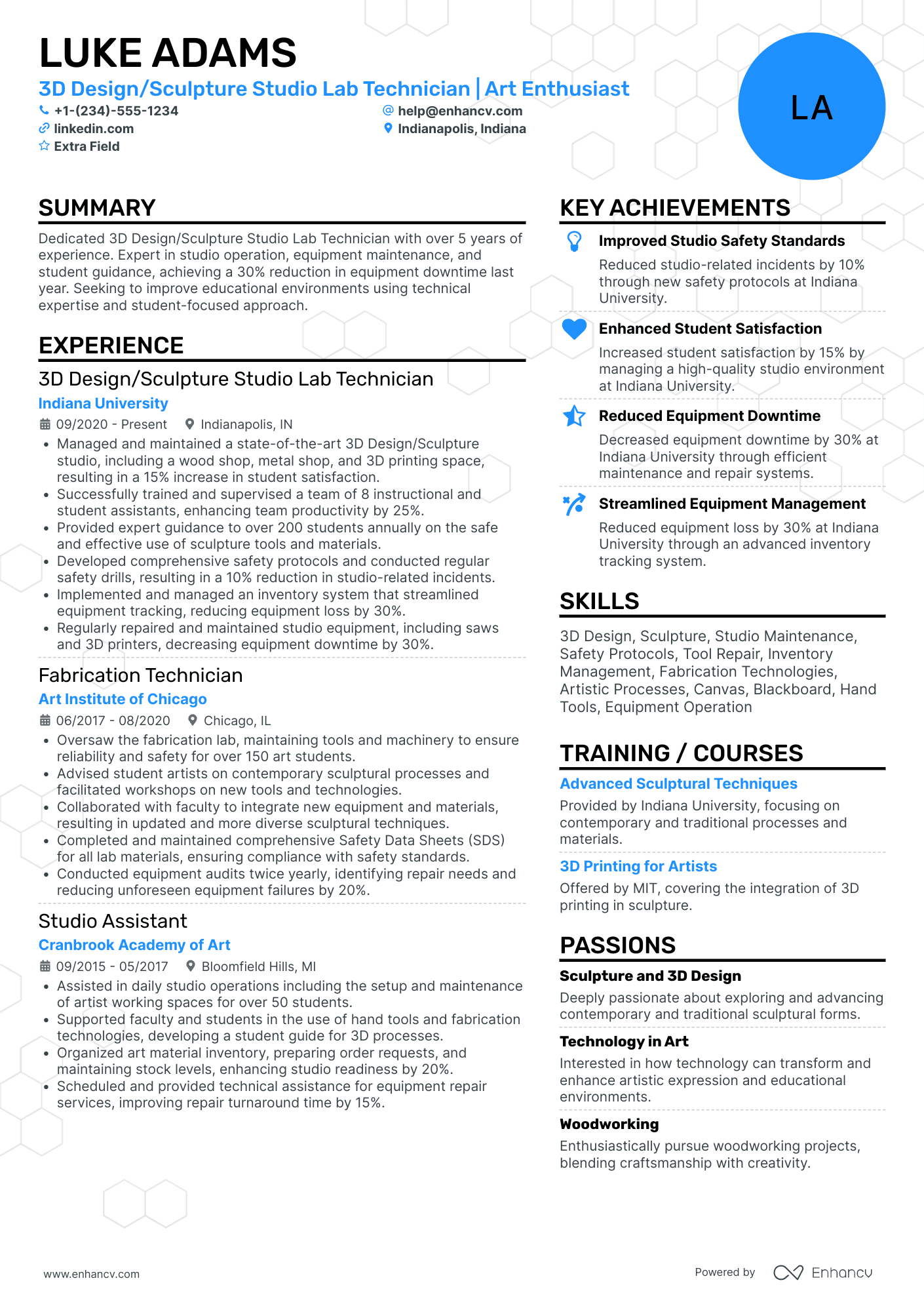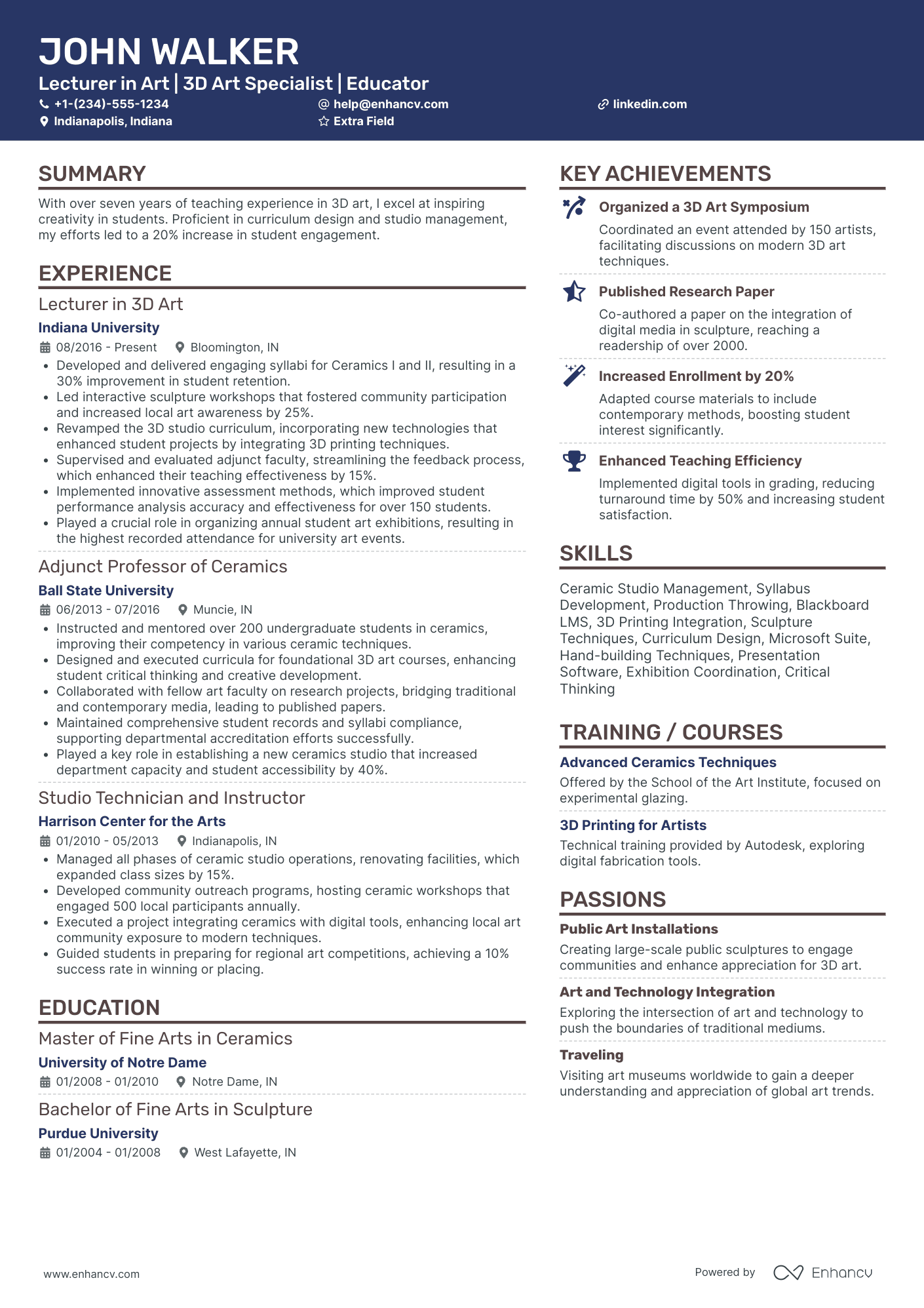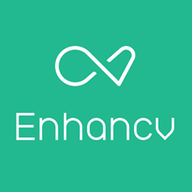As a 3D artist, effectively showcasing the depth and breadth of your skills in a resume can be a significant challenge. Our guide will provide you with targeted advice to structure your resume so that your unique talents capture the attention of potential employers and stand out in the competitive industry.
- Find different 3D artist resume examples to serve as inspiration to your professional presentation.
- How to use the summary or objective to highlight your career achievements.
- How to create the experience section to tell your story.
- Must have certificates and what to include in the education section of your resume.
If the 3D artist resume isn't the right one for you, take a look at other related guides we have:
Formatting the Layout of Your 3D Artist Resume: Design, Length, and More
When it comes to the format of your 3D artist resume , you've plenty of opportunities to get creative. But, as a general rule of thumb, there are four simple steps you could integrate into your resume layout.
- If you have plenty of experience, you'd like to showcase, invest in the reverse-chronological resume format . This format focuses on your latest experience items and skills you've learned during your relevant (and recent) jobs.
- Don't go over the two-page limit, when creating your professional 3D artist resume. Curate within it mainly experience and skills that are relevant to the job.
- Make sure your 3D artist resume header includes all of your valid contact information. You could also opt to display your professional portfolio or LinkedIn profile.
- Submit or send out your 3D artist resume as a PDF, so you won't lose its layout and design.
Your resume should match the market – Canadian applications, for instance, may use a different layout.
Upload & Check Your Resume
Drop your resume here or choose a file. PDF & DOCX only. Max 2MB file size.
PRO TIP
The more trusted the organization you've attained your certificate (or degree) from, the more credible your skill set would be.
The six in-demand sections for your 3D artist resume:
- Top one-third should be filled with a header, listing your contact details, and with a summary or objective, briefly highlighting your professional accolades
- Experience section, detailing how particular jobs have helped your professional growth
- Notable achievements that tie in your hard or soft skills with tangible outcomes
- Popular industry certificates to further highlight your technical knowledge or people capabilities
- Education to showcase your academic background in the field
What recruiters want to see on your resume:
- Proficiency with relevant 3D modeling and animation software (e.g., Autodesk Maya, 3ds Max, Blender, Cinema 4D)
- Strong portfolio showcasing modeling, texturing, lighting, rigging, and animation skills
- Understanding of art principles (e.g., color theory, lighting, shadow, composition and perspective)
- Experience with game engines (e.g., Unity, Unreal Engine) and real-time rendering techniques
- Knowledge of the production pipeline in game development, VFX, or animation studios
Creating Your 3D Artist Resume Experience to Catch Recruiters' Attention
Remember that for the 3D artist role, hiring managers are looking to see how your expertise aligns with their requirements. Here's where your resume experience section can help out. Make sure you:
- Include mainly roles that are relevant to the 3D artist job you're applying for;
- Don't go too far back in your experience - recruiters will only care what you did a decade ago if it's really important for the 3D artist role;
- Each bullet you include should say what you did, followed by the skills you used and the actual end result of your efforts;
- Quantify each of your achievements with numbers and possibly the overall effect it had on the organization;
- Highlight transferrable skills - or personal skills you've attained thanks to past jobs - that could be applicable within your potential workplace. This would showcase your unique value as a professional.
Formatting the experience section of your resume doesn't have to be an over-the-top deep dive into your whole career. Follow the 3D artist resume examples below to see how industry-leading professionals are presenting their experience:
- Spearheaded character modeling and texturing for the award-winning video game series 'Epic Quest,' significantly enhancing visual appeal and character engagement for players.
- Collaborated with a team of 20 designers, contributing to a 30% reduction in production time through the introduction of efficient workflow techniques using ZBrush and Substance Painter.
- Developed detailed 3D assets for use in interactive virtual reality simulations, elevating the immersive experience and receiving recognition for innovation in VR design.
- Managed a department of 3D artists, overseeing project assignments and performance, which directly impacted team productivity and project delivery by 25%.
- Implemented new training programs that enhanced team skills in Unity and Unreal Engine, resulting in the production of high-quality game environments and assets.
- Initiated and led the development of a proprietary tool for real-time 3D asset generation, which streamlined the content creation pipeline and significantly reduced manual modeling hours.
- Designed and produced over 50 different 3D models of interior furniture for IKEA's augmented reality app, driving a 15% increase in app downloads and user engagement.
- Played a key role in developing an automated texturing system that cut down asset creation time by 40%, aligning production processes with the company's fast-paced release schedules.
- Actively participated in cross-departmental meetings to ensure 3D asset compatibility with IKEA's online platform, enhancing the overall user interface and shopping experience.
- Led the design of an innovative 3D simulation for surgical training, which was adopted by several medical institutions and credited for improving surgery preparation efficiency by 35%.
- Mentored junior 3D artists, enhancing team expertise in medical visualization and boosting the department's project execution rate by 20%.
- Optimized 3D asset delivery by integrating cloud-based sharing systems, which facilitated remote collaboration and reduced project turnaround time.
- Created high-quality, photorealistic 3D renders for over 30 commercial real estate properties, which aided in attracting potential investors and led to a sizeable increase in the company's market outreach efforts.
- Implemented 3D scanning technology to produce virtual tours, driving a 50% improvement in client engagement metrics and supporting the company's digital transformation initiatives.
- Worked closely with marketing teams to deliver customized 3D visuals for online campaigns, successfully boosting web traffic by 25% within a six-month timeframe.
- Conceptualized and executed dynamic 3D animations for television commercials, contributing to a 10% increase in client satisfaction scores and repeat business.
- Performed rigorous character rigging for animated sequences, ensuring smooth and lifelike movements that surpassed client expectations and industry standards.
- Mastered motion capture technology to translate real-world performances into digital animations, providing clients with cutting-edge marketing material and a competitive edge.
- Orchestrated the creation of a virtual showroom using Unreal Engine 4 for an automotive client, which was credited with a 20% increase in customer engagement and facilitated remote vehicle demonstrations.
- Developed and managed an asset library containing thousands of car models and parts, reducing search and retrieval time by 60%, thus optimizing the teams' operational efficiency.
- Leveraged scripting and automation skills to improve the accuracy of 3D modeling from CAD data, thereby enhancing the visual fidelity of the final product.
- Produced a wide array of 3D assets, including characters, environments, and props for a mobile gaming studio, which contributed to the app hitting 1 million downloads within the first year of release.
- Pioneered the use of a stylized art direction for the mobile game, 'Tiny Adventures,' that helped differentiate it in a crowded marketplace and increased player retention by 30%.
- Led the integration of 3D models into the gaming engine, optimizing game performance and reducing load times by 40%, enhancing the user experience for players on various devices.
Quantifying impact on your resume
- Highlight the number of 3D models created for various projects to showcase volume of work and proficiency.
- Include the percentage reduction of render times achieved through optimization techniques to demonstrate efficiency gains.
- Mention the amount of time saved on projects due to improved workflows or automation to quantify productivity improvements.
- Document the number of textures and assets developed, emphasizing the diversity and scalability of your skillset.
- Specify the dollar value of projects worked on to highlight your experience with significant budgets and fiscal responsibility.
- Detail the number of collaborative projects and the size of teams worked with to show your teamwork and communication abilities.
- Indicate the percentage increase in social media engagement or sales for projects where your 3D work was a key feature to illustrate real-world impact.
- Report any awards or contests won with numeric ranking, if applicable, to provide a measurable standard of excellence.
Action verbs for your 3D artist resume
How to shift the focus from your 3D artist resume experience section to your professional profile
If you're at the start of your career journey or transitioning industries, you might be concerned about the lack of professional experience while crafting your 3D artist resume.
How can you effectively present your 3D artist resume experience section under these circumstances?
Rather than a traditional, extensive experience section, demonstrate your expertise through:
- Emphasizing your education. Your academic background might impress recruiters, especially if it includes recent, industry-relevant knowledge;
- Creating a compelling objective statement. The first few sentences of your resume should map out your motivations and career aspirations, offering insight into your goals;
- Highlighting your transferable skills. For example, if you've honed communication skills through volunteering, illustrate on your 3D artist resume how these can benefit a potential employer;
- Detailing your technical background in certifications and skills sections. As a recent graduate, your technological foundations might be particularly attractive to employers looking to develop these skills further.
It's important to remember that employers sometimes prefer candidates with less experience but who are a better cultural fit for their organization.
Recommended reads:
PRO TIP
List your educational qualifications and certifications in reverse chronological order.
The Right Balance Between Hard Skills and Soft Skills for Your 3D Artist Resume
Wondering what the perfect 3D artist resume looks like? The candidate's profile meets job requirements by balancing both hard skills and soft skills across their resume.
- Hard skills are all the technologies you're apt at using . Prove you have the right technical background by listing key industry hardware/software in your 3D artist resume skills section and noteworthy certifications.
- Soft skills are both your personal, mindset, communication, analytical, and problem-solving talents . Use your 3D artist resume achievements section to show how you've used a particular soft skill to reach a tangible outcome.
When writing about your unique skill set, always make sure to refer back to the job advert to see what are the key requirements. This ensures you've tailored your resume so that it matches closer to what the ideal candidate profile is.
Top skills for your 3D artist resume:
3D Modeling
Texturing
Lighting
Rigging
Animation
Rendering
ZBrush
Maya
Blender
Substance Painter
Creativity
Attention to Detail
Problem Solving
Time Management
Collaboration
Communication
Adaptability
Critical Thinking
Project Management
Artistic Vision
PRO TIP
Bold the names of educational institutions and certifying bodies for emphasis.
The 3D Artist Resume Sections You May Underestimate: Certifications and Education
Your education and certifications provide insight into both your technical capabilities and personal attributes, such as perseverance. When crafting your 3D artist resume, consider how you present these elements:
- For your higher education degrees, prioritize listing those most relevant to the job or indicative of your academic dedication;
- Include applicable coursework as a stand-in for relevant experience or if it might impress recruiters;
- Include incomplete higher education only if it's pertinent to meeting job requirements;
- If your degree is from a renowned university, mention how often you made the Dean's list to underline academic excellence.
Regarding certifications, it's not necessary to list all of them. Instead, match up to three of your most recent or significant certificates with the technical skills required in the job description.
Below, we've selected some of the top industry certifications that could be vital additions to your 3D artist resume.
The top 5 certifications for your 3D artist resume:
- Autodesk Certified Professional: 3ds Max (ACP) — Autodesk
- Autodesk Certified Professional: Maya (ACP) — Autodesk
- ZBrush Certified User (ZCU) — Pixologic
- Adobe Certified Expert in Photoshop (ACE) — Adobe
- Houdini Certification Program (HCP) — SideFX
PRO TIP
List your educational qualifications and certifications in reverse chronological order.
Recommended reads:
The Ideal 3D Artist Candidate Resume Summary Or Objective
You may have heard that your resume top one-third plays an important part in your application.
It basically needs to show strong alignment with the job advert, your unique skill set, and your expertise.
Both the resume summary and resume objective could be used to ensure you've shown why you're the best candidate for the role.
Use the:
- Resume objective to pinpoint your current successes, that are applicable to the field, and your vision for your career. Remember to state how you see yourself growing within this new career opportunity.
- Resume summary as an instrument to pinpoint what is most applicable and noteworthy form your professional profile. Keep your summary to be no more than five sentences long.
At the end of the day, the resume summary or objective is your golden opportunity to shine a light on your personality as a professional and the unique value of what it's like to work with you.
Get inspired with these 3D artist resume examples:
Resume summaries for a 3D artist job
- Seasoned 3D artist with over 8 years of experience in creating visually stunning environments and characters for AAA games. Proficient with Maya, ZBrush, and Substance Painter, with a portfolio that includes work recognized in the Global Game Awards. Adept at leading teams to push the boundaries of digital artistry in the gaming industry.
- Former industrial designer pivoting to a 3D art career, bringing 5 years of design conceptualization and production experience. Proficient with CAD tools and a quick study in 3D modeling software. Proven track record of creating innovative design solutions that enhance user experience and engagement.
- As a digital marketing professional with 4 years of experience, transitioning to 3D art offers a blend of creative and technical expertise. Skilled in Adobe Creative Suite, looking to leverage understanding of brand storytelling into crafting compelling 3D visuals for interactive media. Recognized for award-winning campaign visuals in previous roles.
- Embarking on a 3D artistry career path with a fresh and eager perspective, aiming to contribute creatively to projects that encompass a strong artistic vision. A recent graduate with a BA in Fine Arts, specializing in digital mediums, seeking to apply theoretical knowledge and honed aesthetic sensibilities in practical, professional settings.
- With a dedicated passion for 3D modeling and animation, and recently having completed an intensive course in 3D design, eager to join a team that values fresh talent and perspectives. Possessing a foundation in Maya, 3ds Max, and Blender, the objective is to grow under guidance and contribute to impactful, visually impressive projects.
Optimize your resume summary and objective for ATS
Drop your resume here or choose a file.
PDF & DOCX only. Max 2MB file size.
What Else Can You Add to Your 3D Artist Resume
What most candidates don't realize is that their 3D artist resumes should be tailored both for the job and their own skillset and personality.
To achieve this balance between professional and personal traits, you can add various other sections across your resume.
Your potential employers may be impressed by your:
- Awards - spotlight any industry-specific achievements and recognitions that have paved your path to success;
- Languages - dedicate some space on your 3D artist resume to list your multilingual capabilities, alongside your proficiency level;
- Publications - with links and descriptions to both professional and academic ones, relevant to the role;
- Your prioritization framework - include a "My Time" pie chart, that shows how you spend your at-work and free time, would serve to further backup your organization skill set.
Key Takeaways
We trust that this Enhancv guide has been informative and useful. To summarize the essential points:
- Opt for a simple and readable format, focusing more on your 3D artist achievements rather than just duties;
- Emphasize your accomplishments in the 3D artist experience section over mere responsibilities;
- If lacking relevant experience, utilize various resume sections like education and volunteering to demonstrate your suitable skill set;
- Never overlook the significance of pertinent higher education, training, and certifications;
- Incorporate diverse sections in your resume to highlight not just your skills expertise but also your personality.
3D Artist resume examples
By Experience
By Role
